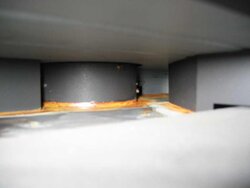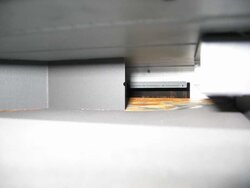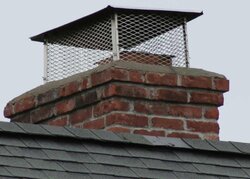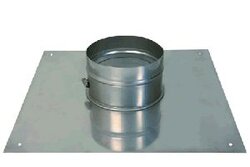I was cleaning out the PE Summit Insert this morning when i looked onto of the stove between the surround and the top, I noticed there was rust on the top. I remember hearing water dripping in when we had one of the heavy rain storms. When the installer put the stove in, he "inverted" the top plate and epoxied it to the terracotta tile coming out of the chimney. I would imagine that it is leaking around that seal. If it wee coming down the liner, i would imagine water would get inside the stove. This stove was installed by a dealer last December. Will this cause permanent damage to the stove, and what do you recommend should be done here.
Leaking and rust on the top of insert
- Thread starter chris2879
- Start date
-
Active since 1995, Hearth.com is THE place on the internet for free information and advice about wood stoves, pellet stoves and other energy saving equipment.
We strive to provide opinions, articles, discussions and history related to Hearth Products and in a more general sense, energy issues.
We promote the EFFICIENT, RESPONSIBLE, CLEAN and SAFE use of all fuels, whether renewable or fossil. -
Super Cedar firestarters 30% discount Use code Hearth2024 Click here
You are using an out of date browser. It may not display this or other websites correctly.
You should upgrade or use an alternative browser.
You should upgrade or use an alternative browser.
- Status
- Not open for further replies.
Do you have a chimney cap on it? If you do, then I'm guessing the epoxy has broken loose. The top plate really should completely cover the terracotta. Mine is over top of if and then bent over the sides a bit. I would call the dealer and have them fix it and I might even demand they install the top plate properly. Try being nice to them about it, but if all else fails take a pic of the top plate and send it and these two to PE.
Pics would help here. How did he "invert" the top plate? Is there a storm collar on this? Is the rim facing downward along the sides of the flue tile or is it facing upward, like a pan?
It is not facing upward for sure. I believed he installed it to be flat and just glued it. I do not believe it is installed to "fit" over the tile. The way He installed it, the clamp is downward, below the top of the tile.
Sometimes installers will invert the top plates to allow for more clearance between the top of the liner and the existing chimney cap. Do you have a cap on the chimney? It's probably worth a trip up there to see if anything is loose.
I highly doubt the rust you currently have is anything more than a cosmetic issue, though you should figure out how the water is getting in and stop it.
I highly doubt the rust you currently have is anything more than a cosmetic issue, though you should figure out how the water is getting in and stop it.
I think I've got it. Are they inverting the rolled up drip rim on the top plate? If so, I would pull off the top cap and flip the plate with a short extension to the liner if necessary. The drip rim serves a good purpose. I would also fold over the edges of the cap so that they form a drip edge. Seal it to the flue pipe with a generous bead of good silicone adhesive.
That sounds to be exactly what they did. Attached is a picture of the chimney and the type of flat top plate they used. When installed the clamp was below the top plane of the chimney, i guess this is why he called it inverted. Looking back, maybe i should have asked him to use one that will "fit: the tile, therefore no water would get in from that spot.
Unfortunately one of the main reasons i paid someone to install it that the top of the chimney is about 35 ft off the ground and about 8 ft above the roof that has at least a 10 pitch to it. I am not sure how to get up there and check it out...
I would assume this is a installation issue and he should fix it right?
Unfortunately one of the main reasons i paid someone to install it that the top of the chimney is about 35 ft off the ground and about 8 ft above the roof that has at least a 10 pitch to it. I am not sure how to get up there and check it out...
I would assume this is a installation issue and he should fix it right?
Attachments
I spoke with the installer. He said that an inverted top plate installation is "not uncommon in the industry" as a perfectly safe way to terminate the liner. Does everyone agree.
Furthermore, he said when he did the install last year, the cement chimney crown had 4 cracks in it, which he filled the cracks last december with silicon. The chimney is multiflue with a 12x12 and a 8x8 flues. When talking to him, he claims that his install is perfectly fine and the water must be coming from the cracks in the cement cap. For some reason that does not make any sense to me... since the water is on the top of my insert. I would think that the water is coming down the liner, within the 12x12 chimney tile. Even if water got into the cracks, would that end up on the top of the stove, or would that just degrade the bricks. The liner is connected directly to the top of the stove then running up the chimney to the inverted top plate. There are no tee's or anythign in the installation.
What do you think?
Furthermore, he said when he did the install last year, the cement chimney crown had 4 cracks in it, which he filled the cracks last december with silicon. The chimney is multiflue with a 12x12 and a 8x8 flues. When talking to him, he claims that his install is perfectly fine and the water must be coming from the cracks in the cement cap. For some reason that does not make any sense to me... since the water is on the top of my insert. I would think that the water is coming down the liner, within the 12x12 chimney tile. Even if water got into the cracks, would that end up on the top of the stove, or would that just degrade the bricks. The liner is connected directly to the top of the stove then running up the chimney to the inverted top plate. There are no tee's or anythign in the installation.
What do you think?
There are lots of common things in the industry that end up as problems. No argument about safety here, that is not the question. This is an issue of water infiltration. Sounds like a difference of opinion on one hand and direct evidence on the other. Will he come out and try your solution of siliconing in a short stub? Pay him for it if this is a high roof.
M
mhrischuk
Guest
chris2879 said:That sounds to be exactly what they did. Attached is a picture of the chimney and the type of flat top plate they used. When installed the clamp was below the top plane of the chimney, i guess this is why he called it inverted. Looking back, maybe i should have asked him to use one that will "fit: the tile, therefore no water would get in from that spot.
Unfortunately one of the main reasons i paid someone to install it that the top of the chimney is about 35 ft off the ground and about 8 ft above the roof that has at least a 10 pitch to it. I am not sure how to get up there and check it out...
I would assume this is a installation issue and he should fix it right?
What I see in those pictures is an install that is almost designed to get water down the flue. You have a hole at the top, not much different than a conventional fireplace chimney. The difference here is that with a conventional fireplace, you don't worry much about water intrusion. It's all masonry.
In my opinion they should not have inverted the top plate. They should have replaced that rain cap with one designed for the liner install.... the round ones.
At this point, if that was mine, I would at minimum, have a short piece of pipe installed and siliconed around the seam to help keep wind driven rain from getting in there.
Another possible solution would be to wrap outside of the the cage with maybe 3-4" wide sheet stock around the base. While up there apply a "dam" if silicone around the hole to help prevent water from simply pooling and running down the flue. You realize that when that liner is clamped, the weight of the liner can cause the top plate buckle downwards slightly, causing it to be a water dish that drains into the flue.
Personally, I would change something for sure.
Unfortunately he is pretty much wiping his hands of this, so getting him to do anything will be a battle. I think i am going to fix this myself (should have done this install myself looking back now).
As for the top plate being "pulled" down, that is exactly what I was telling my wife yesterday might have also happened. When i get up there will have a camera and a straight edge and be checking this for sure.
I think my go forward plan will be getting a terra-cotta 13x13 top plate that fits over the tile with the pressure mount screws. I am going to install it over top of the inverted plate (the 2 plate will be back to back and adhered with silicone). This way, i do not have to worry about extending the liner since it will be a few inches short. The new top plate will cap the flat plate (pan like it facing downward), adding more weather proofing to the seal of the current siliconed flat top plate adhered to the top of the flue tile. By adding top plate mounted in the correct direction, it will the protect water from funneling down the flue. Since this will be a couple inches taller and he was originally worried about the multi flue cap, i am going to install a taller one. How high to the collars stick up from the flat part of the top plate? I am guessing the flue tile is about 3" above the cement chimney cap now. And what is the recommended clearance from the flue to the rain cap?
Thanks again hearth.com, you have all been more than helpful!
As for the top plate being "pulled" down, that is exactly what I was telling my wife yesterday might have also happened. When i get up there will have a camera and a straight edge and be checking this for sure.
I think my go forward plan will be getting a terra-cotta 13x13 top plate that fits over the tile with the pressure mount screws. I am going to install it over top of the inverted plate (the 2 plate will be back to back and adhered with silicone). This way, i do not have to worry about extending the liner since it will be a few inches short. The new top plate will cap the flat plate (pan like it facing downward), adding more weather proofing to the seal of the current siliconed flat top plate adhered to the top of the flue tile. By adding top plate mounted in the correct direction, it will the protect water from funneling down the flue. Since this will be a couple inches taller and he was originally worried about the multi flue cap, i am going to install a taller one. How high to the collars stick up from the flat part of the top plate? I am guessing the flue tile is about 3" above the cement chimney cap now. And what is the recommended clearance from the flue to the rain cap?
Thanks again hearth.com, you have all been more than helpful!
M
mhrischuk
Guest
I would want 3-4" minimum from the top of the pipe to the underside of the cap. The second top plate is a great idea.
Looks like an extendaflue would do this job well. Shoot a PM to webmaster about this product.
http://www.extendaflue.com/
http://www.extendaflue.com/
- Status
- Not open for further replies.
Similar threads
- Replies
- 17
- Views
- 1K
- Replies
- 2
- Views
- 502
- Replies
- 5
- Views
- 1K
- Replies
- 8
- Views
- 2K





